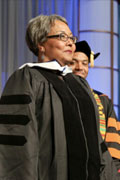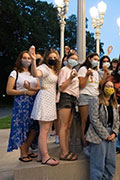Brandeis Alumni, Family and Friends

Brandeis at a Glance
Rankings and Brandeis among peer institutions
- Brandeis is one of just 62 institutions in the United States and Canada that belong to the prestigious American Association of Universities. Membership is based on quality of academic research and scholarship, and undergraduate, graduate and professional education.
- Brandeis is ranked 35th out of 280 national universities overall in the latest U.S. News & World Report survey.
 Brandeis' economics program is ranked among the top 10 in the country. And it should be no surprise: Provost Lisa Lynch (right), P'17, the Maurice B. Hexter Professor of Social and Economic Policy, is a former chief economist at the U.S. Department of Labor.
Brandeis' economics program is ranked among the top 10 in the country. And it should be no surprise: Provost Lisa Lynch (right), P'17, the Maurice B. Hexter Professor of Social and Economic Policy, is a former chief economist at the U.S. Department of Labor.- USA Today ranked Brandeis sixth nationally for sociology majors.
- The Brandeis Department of Education is ranked ninth nationally in a survey by College Factual.
- Brandeis is No. 19 out of 280 national universities in alumni participation, according to the latest U.S. News & World Report rankings.
- Brandeis graduates are accepted to medical and law school at nearly twice the national average.
Faculty
Brandeis has always had a commitment to intellectual giants.
 Early faculty included Max Lerner, journalist and political scientist; Herbert Marcuse, philosopher, sociologist and political theorist; Abe Maslow (right), psychologist; Eleanor Roosevelt, diplomat, human rights activist and former First Lady; Leonard Bernstein, American composer, conductor, author, music lecturer and pianist; and Irving Fine, music composer.
Early faculty included Max Lerner, journalist and political scientist; Herbert Marcuse, philosopher, sociologist and political theorist; Abe Maslow (right), psychologist; Eleanor Roosevelt, diplomat, human rights activist and former First Lady; Leonard Bernstein, American composer, conductor, author, music lecturer and pianist; and Irving Fine, music composer.- Brandeis faculty today: Based on size, a disproportionately high number of Brandeis faculty belong to the American Academy of Arts and Sciences, National Academy of Sciences and the American Academy of Arts and Letters or are Howard Hughes Medical Institute investigators.
Incoming students
- More than 10,000 students — an all-time high — applied for a spot in the Class of 2018.
- 89% of the Class of 2018 ranked in the top 20% of their high school class.
- The median SAT score for the Class of 2018 is 1345 out of 1600 (math and critical reading).
Commitment to Social Justice
Brandeis has been committed to social justice since the University's founding. The University has always been open to students and faculty without regard to race, religion, ethnic origin or the ability to pay — a bold, pioneering policy at the University’s inception. That commitment continues. For instance:
- In a New York Times survey, Brandeis ranked eighth among national universities with the most economically diverse student bodies. The ranking was based on two factors: the share of freshmen from low-income families and the price of attendance for low- and middle-income families (adjusting for financial aid). The seven universities ranked ahead of Brandeis have significantly larger endowments than Brandeis does.
 Brandeis’ annual festival of social justice — ’Deis Impact — is believed to be the nation’s only college-based festival of social justice. The 10-day celebration, established by students in 2012, features more than 60 programs and events organized by individual students, student groups and faculty.
Brandeis’ annual festival of social justice — ’Deis Impact — is believed to be the nation’s only college-based festival of social justice. The 10-day celebration, established by students in 2012, features more than 60 programs and events organized by individual students, student groups and faculty.- Brandeis ranks fourth among national universities in the percentage of graduates from 2000-2010 (28 percent) who entered public service, according to a survey by Washington Monthly.
- Brandeis undergraduates performed 80,000 hours of volunteer work during the 2013-14 academic year, an average of more than 20 hours per student.
Academic Departments
Sciences
- When normalized for size, Brandeis faculty receive more grant support from the National Institutes of Health for sponsored research than do faculty at Harvard, Princeton, Brown, NYU, Tufts or Boston University. In a recent year, Brandeis received 85 awards for a total of $26.3 million, an average of $72K for each of 361 faculty members. Peer schools: Harvard, $18.6K; Princeton, $27K; Brown, $20K; NYU, $19K; Tufts, $18K; and Boston University, $22K.
- Professor Eve Marder ’69, the Victor and Gwendolyn Beinfield Professor of Neuroscience, is one of 14 U.S. scientists on the advisory board of President Obama’s BRAIN (Brain Research through Advancing Innovative Neurotechnologies) Initiative.
 Professors Michael Rosbash (right), the Peter Gruber Endowed Chair in Neuroscience, and Jeff Hall (emeritus) won the 2012 Canada Gairdner International Award, one of the world’s top prizes for biomedical research, for discovering the genetic basis for biological rhythms fundamental to life. The Gairdner Award is known as a “Nobel predictor” since so many of its recipients have gone on to win the Nobel Prize.
Professors Michael Rosbash (right), the Peter Gruber Endowed Chair in Neuroscience, and Jeff Hall (emeritus) won the 2012 Canada Gairdner International Award, one of the world’s top prizes for biomedical research, for discovering the genetic basis for biological rhythms fundamental to life. The Gairdner Award is known as a “Nobel predictor” since so many of its recipients have gone on to win the Nobel Prize.- Since 2003, Brandeis undergraduates have been co-authors with faculty on more than 220 articles that were published in peer-reviewed scientific journals.
- An extraordinarily high number of Brandeis life science faculty are women. Fourteen of the 29 professors in the biology department are women. In recent years, women scientists have served as provost, dean of arts and sciences, and chaired the departments of biology, physics, chemistry and biochemistry.
- The Neuroscience Department's 27 faculty include six members of the National Academy of Sciences; one MacArthur Fellow (known as the “genius" grant); two Howard Hughes Medical Institute Investigators; three winners of the Gruber Neuroscience Prize (arguably the top prize in neuroscience) since the prize’s establishment in 2004; and dozens of other prize winners (Javits, Merit Awards, Brain Initiative Awards, Gerard Prize, Sloan, McKnight, etc.).
- The National Research Council ranked the graduate program in the top 10 nationally (roughly sixth), in the company of Harvard; MIT; Stanford; University of California, San Diego; University of California, San Francisco; Johns Hopkins; and Yale.
- Brandeis is home to one of five Sloan/Swartz Centers for Computational Neuroscience.
- Brandeis received a major grant from the U.S. Department of Defense to establish the Center for Behavioral Genomics in 2000.
- Seminal contributions from Brandeis neuroscientists include: The pioneering work of Rosbash and Hall in the 1980s on the molecular basis of the circadian clock helped launch the field of behavioral genetics, and earned them the Gruber Prize in 2009. ... Professor Chris Miller conducted seminal work on ion channel structure and function and his lab trained Roderick MacKinnon '78 (as an undergraduate and later as a postdoc), who went on to receive a Nobel Prize in 2003. ... Marder's work in the 1980s and '90s showed that the same set of neurons can be reconfigured to generate multiple behaviors, and changed forever the view that circuits are anatomically “hardwired.” This and a lifetime of groundbreaking ideas earned her the Gerard Prize in 2005 and the Gruber in 2013. ... The discovery of “homeostatic” synaptic plasticity in 1998 by Gina Turrigiano and Sacha Nelson produced a paradigm shift in the field of synaptic plasticity, launched an entirely new field that continues to grow exponentially, and has profoundly influenced the way neuroscientists think about brain assembly, stability and plasticity. Based on this and other work, Turrigiano received a MacArthur Foundation “genius” grant in 2000. ... In the '90s, Brandeis pioneered collaborations between theoreticians and experimentalists, leading to new insights into how neural circuits function. Based largely on work carried out at Brandeis, Larry Abbott received the Swartz Prize in theoretical neuroscience in 2010.
Creative Arts
Creative Arts at Brandeis has, since its inception, been vibrant, innovative and led by esteemed faculty.
- More than 30 Guggenheim Fellowships have been awarded to faculty, students and alumni.
- Four music faculty have won Pulitzer Prizes.
- Theater faculty have won five Tony Awards, a Helen Hayes Award, a Drama Desk Award, an Obie Award and others.
- Fine Arts faculty have received awards from the Ford Foundation and the American Academy of Arts and Letters, and fellowships from the National Endowment for the Arts, Golda Meir Foundation, Fulbright and others.
 The first Brandeis Festival of the Creative Arts was produced in 1952 as part of the first Commencement. It received a full page of reviews and features in The New York Times and Life magazine. The festival featured the U.S. premiere of The Threepenny Opera by Kurt Weill, Les Noces by Igor Stravinsky, Trouble in Tahiti by Leonard Bernstein (right), and the first performance in the U.S of a new form of music, musique concrète, with choreography by Merce Cunningham, who had recently left Martha Graham’s company. Brandeis holds its annual Bernstein Festival of the Creative Arts every spring.
The first Brandeis Festival of the Creative Arts was produced in 1952 as part of the first Commencement. It received a full page of reviews and features in The New York Times and Life magazine. The festival featured the U.S. premiere of The Threepenny Opera by Kurt Weill, Les Noces by Igor Stravinsky, Trouble in Tahiti by Leonard Bernstein (right), and the first performance in the U.S of a new form of music, musique concrète, with choreography by Merce Cunningham, who had recently left Martha Graham’s company. Brandeis holds its annual Bernstein Festival of the Creative Arts every spring.- There are 75 declared majors in the Creative Arts program.
- The Rose Art Museum has one of the finest collections of post-war contemporary art in New England. Chris Bedford, the Henry and Lois Foster Director of the Rose, has mounted critically acclaimed exhibitions and coordinated the outdoor installation “Light of Reason.” The Rose recently won $100K grants from the Andy Warhol Foundation for the Visual Arts and the Andrew W. Mellon Foundation.
Fundraising
Gifts from alumni help Brandeis maintain its standing as an elite educational institution that fosters excellence, creativity and tolerance. Three class fundraising initiatives:
- Class of 1980 I am Brandeis Presidential Scholarship: $10,000 merit-based award to a rising Brandeis senior who best reflects award selection criteria; four recipients over four years. Must raise $40,000. Selection criteria: In light of world events that demonstrate intolerance and lack of humanity, this scholarship goes to a rising Brandeis senior who best reflects the ideals of Louis D. Brandeis and the University's founders. Specifically, those ideals are the promotion of understanding, tolerance and truth even unto its innermost parts. (If we do not reach $10,000 — and multi-year pledges for $40,000 — by June 30, funds will go to general scholarship fund.)
- The Lewis Brooks ’80 Bench: To honor our classmate who, since his first day at Brandeis, has been devoted to documenting happenings at Brandeis and our class in particular. In consideration for the man who rarely sits down, the bench repsesents a place on campus to take a break. Donations: $100 apiece.
- Brandeis Alumni Annual Fund: Used in a variety of ways to meet the University's most pressing needs, including scholarship assistance, faculty support, student housing, laboratories and classrooms.
We aim for at least 40% of our class to participate in our Class of 1980 fundraising. It's vital for Brandeis and, as an added benefit, will reflect well in the University's U.S. News & World Report rankings.







 Brandeis' economics program is ranked among the top 10 in the country. And it should be no surprise: Provost Lisa Lynch (right), P'17, the Maurice B. Hexter Professor of Social and Economic Policy, is a former chief economist at the U.S. Department of Labor.
Brandeis' economics program is ranked among the top 10 in the country. And it should be no surprise: Provost Lisa Lynch (right), P'17, the Maurice B. Hexter Professor of Social and Economic Policy, is a former chief economist at the U.S. Department of Labor. Early faculty included Max Lerner, journalist and political scientist; Herbert Marcuse, philosopher, sociologist and political theorist; Abe Maslow (right), psychologist; Eleanor Roosevelt, diplomat, human rights activist and former First Lady; Leonard Bernstein, American composer, conductor, author, music lecturer and pianist; and Irving Fine, music composer.
Early faculty included Max Lerner, journalist and political scientist; Herbert Marcuse, philosopher, sociologist and political theorist; Abe Maslow (right), psychologist; Eleanor Roosevelt, diplomat, human rights activist and former First Lady; Leonard Bernstein, American composer, conductor, author, music lecturer and pianist; and Irving Fine, music composer. Brandeis’ annual festival of social justice — ’Deis Impact — is believed to be the nation’s only college-based festival of social justice. The 10-day celebration, established by students in 2012, features more than 60 programs and events organized by individual students, student groups and faculty.
Brandeis’ annual festival of social justice — ’Deis Impact — is believed to be the nation’s only college-based festival of social justice. The 10-day celebration, established by students in 2012, features more than 60 programs and events organized by individual students, student groups and faculty. Professors Michael Rosbash (right), the Peter Gruber Endowed Chair in Neuroscience, and Jeff Hall (emeritus) won the 2012 Canada Gairdner International Award, one of the world’s top prizes for biomedical research, for discovering the genetic basis for biological rhythms fundamental to life. The Gairdner Award is known as a “Nobel predictor” since so many of its recipients have gone on to win the Nobel Prize.
Professors Michael Rosbash (right), the Peter Gruber Endowed Chair in Neuroscience, and Jeff Hall (emeritus) won the 2012 Canada Gairdner International Award, one of the world’s top prizes for biomedical research, for discovering the genetic basis for biological rhythms fundamental to life. The Gairdner Award is known as a “Nobel predictor” since so many of its recipients have gone on to win the Nobel Prize. The first Brandeis Festival of the Creative Arts was produced in 1952 as part of the first Commencement. It received a full page of reviews and features in The New York Times and Life magazine. The festival featured the U.S. premiere of The Threepenny Opera by Kurt Weill, Les Noces by Igor Stravinsky, Trouble in Tahiti by Leonard Bernstein (right), and the first performance in the U.S of a new form of music, musique concrète, with choreography by Merce Cunningham, who had recently left Martha Graham’s company. Brandeis holds its annual Bernstein Festival of the Creative Arts every spring.
The first Brandeis Festival of the Creative Arts was produced in 1952 as part of the first Commencement. It received a full page of reviews and features in The New York Times and Life magazine. The festival featured the U.S. premiere of The Threepenny Opera by Kurt Weill, Les Noces by Igor Stravinsky, Trouble in Tahiti by Leonard Bernstein (right), and the first performance in the U.S of a new form of music, musique concrète, with choreography by Merce Cunningham, who had recently left Martha Graham’s company. Brandeis holds its annual Bernstein Festival of the Creative Arts every spring.